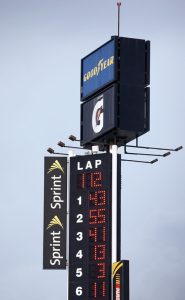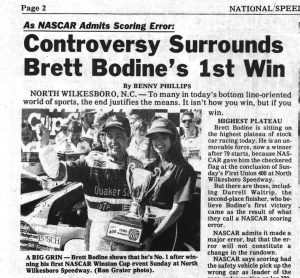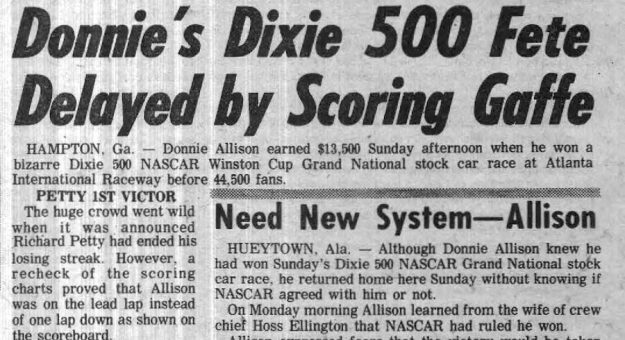Unlike stick-and-ball sports where only two teams compete against one another, dozens of drivers participating in the same auto race requires tracking each car over hundreds of laps.
Through the years, a variety of procedures have been used to score cars.
As far back as the inaugural Indianapolis 500 in 1911, the 40-car field crossed over a wire to create an imprint on a timecard. Timing-and-scoring workers noted which car tripped the wire to build a running order for each lap. That is until an accident occurred and wiped out the scoring stand on lap 137.
Laps 138 through 176 of the 200-lap race were not recorded, leaving Ray Harroun’s victory in question.
When NASCAR ran strictly stock and modified events on the Beach and Road Course in Daytona Beach, Fla., during the 1950s, there’s no doubt the crowd was sometimes confused by the running order in those events.
“There would have been a public address system in all of those early races but not much more,” said Ken Martin, director of historical content for NASCAR. “I’ve heard (former broadcaster and SPEED SPORT editor) Chris Economaki talk about how inaccurate he may have been when announcing races there. The only way to have done that correctly would have been to see the entire course in a helicopter. There was no way to see it from the announcer’s booth.
“Also, a lot of those cars had numbers that were taped on with masking tape and the tape would come off. So those announcing would say the green car, black car, white car or brown car and there were no specifications of how big the numbers had to be.”

For a brief time in 1955, NASCAR used a system where one letter of the alphabet was placed on left-front fender of each car. As the cars would come to a point on the track, stenographers would type the letter on a sheet of paper to log each car as it passed. That scoring system lasted only a few races.
For decades, NASCAR used a score-card system. After the green flag waved, scorers would watch for their car and write down the number that was on the scoring box or digital clock as the car passed the scoring line. If a car was missed, NASCAR officials would find the two cars closest to that car and give the scorer a number to enter on the score sheet.
Drivers and teams provided their own scorers with many working in that capacity for decades. During the early days, crew members were often sent to the scoring stand to check on where their cars were on the track, as there was no way to check a car’s running position from the pits.
The system was exceptionally good, but there were occasional problems.
NASCAR’s first known scoring dispute came on Sept. 7, 1951, at Columbia (S.C.) Speedway. Tim Flock was declared the winner of the 100-mile race after leading 128 of 200 laps. Glenn “Fireball” Roberts was flagged the winner with Flock in second.
Flock’s team owner, Ted Chester, asked for a check of the score cards. Ed Saverance, Roberts’ team owner, protested and was so angry he refused the $700 second-place money, but NASCAR’s decision stood.
Starting the next week at Langhorne (Pa.) Speedway, a rectangular flop-clock was employed to help scorers seated in the grandstand note continuous numbers on the score sheets.
One of the most controversial scoring mix-ups of the 1960s came during the 1962 Southern 500. It was deemed the most embarrassing scoring foul up in NASCAR’s then 12-year history. Junior Johnson was flagged the winner, but an official statement made at midnight on Labor Day evening gave the victory to Indianapolis native Larry Frank.
As it turned out, Johnson was a lap down.
“I got past the checkered flag, pulled my car down into the grass and parked it,” Frank said. “I never went to victory lane. I walked past it when Junior was there, and I was pretty bitter about it. Junior wasn’t even on the same lap.”
Press members argued Frank had won after he led the final 80 laps.
After chief scorer Joe Epton cross-checked the score cards, Frank was awarded the victory.
Another memorable scoring snafu came on Nov. 5, 1978, at Atlanta Motor Speedway. For hours following the race, Donnie Allison and Richard Petty each claimed to have won after Allison made up two laps late in the running.
“With eight laps to go, we lined up and Dave Marcis was in the lead. I was next and Petty was behind me,” Allison said. “Petty tried to come by me down the back straightaway in turn two. I pinched him over against the wall and motioned for him to get behind me.
“The race restarted and we got into turn one and the caution came out. I made up two laps in six laps. I called (team owner) Hoss (Ellington) on the radio and told him he’d better get NASCAR straightened out because I was about to win this race. No one could run with me.”
Allison got back on the lead lap during a lap-321 yellow flag, however, most believed him to still be one lap behind Petty and Marcis, who were thought to be battling for the lead.
According to the race report in the Nov. 8 issue of National Speed Sport News, Allison went to victory lane, but Petty was taken to the press box for the winner’s interview. More than two hours after the checkered flag, Allison was declared the winner.
“There was a small building there and (NASCAR president) Bill France Jr. said to me, ‘Let Joe Epton show you where you didn’t win the race.’ I said, ‘No. I’ll go in there, but he can’t show me that I didn’t win the race because I did.’ I go in that room and Joe is sweating like he’s in a sauna and it’s pretty chilly.
“I told Billy, ‘If you take this win away from me, I’ll whip your butt until your mother won’t know who you are.’ I left. NASCAR never to this day called me and told me I won that race,” Allison concluded. “Clyde Bolton of the Birmingham News called me and said, ‘They gave you the race.’ I said, ‘No, they didn’t give it to me. I won it.’”

On April 22, 1990, Brett Bodine led the final 82 laps at North Wilkesboro (N.C.) Speedway to log his only NASCAR Cup Series victory. During the final caution period, which began on lap 321 of the 400-lap race, NASCAR ordered several drivers to pass the pace car to move them into the correct order on the 0.625-mile track.
NASCAR officials said the caution car mistakenly picked up Dale Earnhardt when the yellow flag waved instead of Bodine, who was the leader. Even though Bodine pitted during the caution and Darrell Waltrip and Earnhardt didn’t, NASCAR gave the leader’s spot back to Bodine after studying the score cards for 18 laps under caution.
“The pace car picked up the wrong car under caution,” said Bodine, who later became NASCAR’s pace car driver. “I was jumping up and down in the car because I knew what had happened. But then the NASCAR officials got everything sorted out and put us in the right order.
“(Crew chief) Larry (McReynolds) told me over the radio that Waltrip was catching me right there at the end, but he told me not to panic. I was just concentrating on running a good, smooth line around the track and hoping Darrell would wear himself out trying to catch me.”
To this day, Waltrip and others who were in the garage that day do not believe Bodine should have been the leader for the restart.
Since May 1993, all NASCAR Cup Series, Xfinity Series and Camping World Truck Series races have been electronically scored by NASCAR.
“Technology has evolved tremendously in recent years, and has become an incredibly useful tool in scoring NASCAR races,” said Kyle McKinney, NASCAR’s director of scoring. “At any given time, we know where each race vehicle is on the track — whether it’s in turn two or pit road. Precision is vital for all facets of our sport, and NASCAR timing and scoring is as precise as it’s ever been in our 70-plus year history.”
Timing loops are currently used with the most critical timing loops being placed at the start-finish line. A transponder is placed at the left rear of each race car at an exact predetermined distance.
By doing so, lap times can be determined to thousands of a second and viewed on computer screens at NASCAR control as well as by crew members on pit road.
